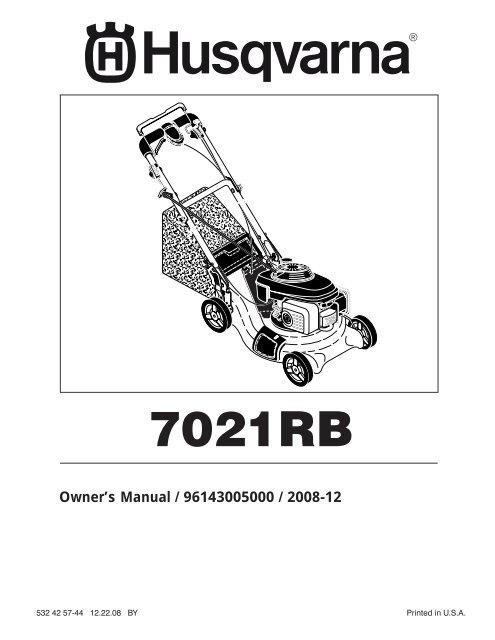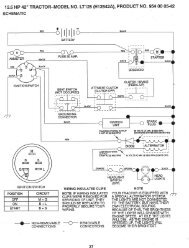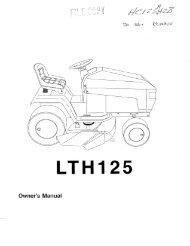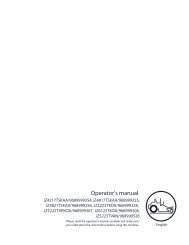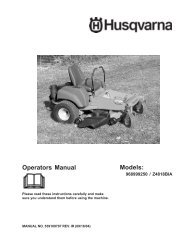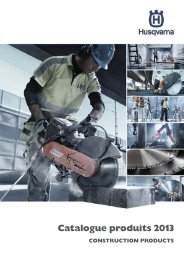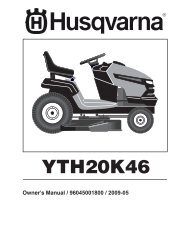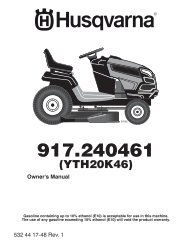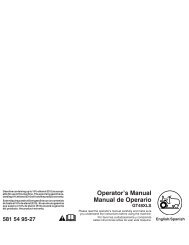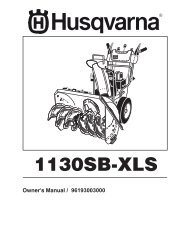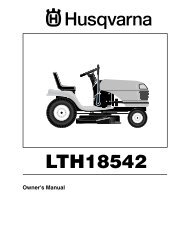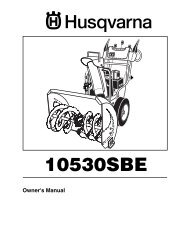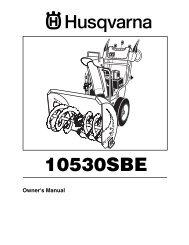OM, 7021 RB, 96143005000, 2008-12, Walk Mower - Husqvarna
OM, 7021 RB, 96143005000, 2008-12, Walk Mower - Husqvarna
OM, 7021 RB, 96143005000, 2008-12, Walk Mower - Husqvarna
You also want an ePaper? Increase the reach of your titles
YUMPU automatically turns print PDFs into web optimized ePapers that Google loves.
<strong>7021</strong><strong>RB</strong><br />
Owner’s Manual / <strong>96143005000</strong> / <strong>2008</strong>-<strong>12</strong><br />
532 42 57-44 <strong>12</strong>.22.08 BY Printed in U.S.A.
SAFETY RULES<br />
Safe Operation Practices for <strong>Walk</strong>-Behind <strong>Mower</strong>s<br />
IMPORTANT: THIS CUTTING MACHINE IS CAPABLE OF AMPUTATING HANDS AND FEET AND THROW ING OBJECTS. FAILURE<br />
TO OBSERVE THE FOLLOWING SAFETY INSTRUCTIONS COULD RESULT IN SERIOUS INJURY OR DEATH.<br />
Look for this symbol to point out impor<br />
tant safety precautions. It means<br />
CAUTION!!! BE C<strong>OM</strong>E ALERT!!! YOUR<br />
SAFE TY IS IN VOLVED.<br />
CAUTION: Always disconnect spark plug<br />
wire and place wire where it cannot contact<br />
spark plug in order to prevent ac ci den tal<br />
starting when setting up, trans port ing,<br />
adjusting or making re pairs.<br />
WARNING: Engine exhaust, some of its constit<br />
u ents, and certain vehicle com po nents<br />
contain or emit chem i cals known to the<br />
State of Cal i for nia to cause can cer and birth<br />
defects or oth er re pro duc tive harm.<br />
WARNING: Battery posts, terminals and<br />
related ac ces so ries contain lead and lead<br />
compounds, chemicals known to the State<br />
of Cal i for nia to cause can cer and birth<br />
defects or oth er re pro duc tive harm. Wash<br />
hands after handling.<br />
CAUTION: Muffler and other engine parts<br />
become extremely hot during operation<br />
and remain hot after engine has stopped.<br />
To avoid severe burns on contact, stay away<br />
from these areas.<br />
I. GENERAL OPERATION<br />
• Read, understand, and follow all instructions on the<br />
machine and in the manual(s) before starting. Be<br />
thor ough ly familiar with the controls and the proper<br />
use of the machine before starting.<br />
• Do not put hands or feet near or under rotating parts.<br />
Keep clear of the discharge opening at all times.<br />
• Only allow responsible individuals, who are familiar<br />
with the instructions, to operate the machine.<br />
• Clear the area of objects such as rocks, toys, wire,<br />
bones, sticks, etc., which could be picked up and<br />
thrown by the blade.<br />
• Be sure the area is clear of other people before mowing.<br />
Stop machine if anyone enters the area.<br />
• Do not operate the mower when barefoot or wearing<br />
open sandals. Always wear substantial foot wear.<br />
• Do not pull mower backwards unless absolutely neces<br />
sary. Always look down and behind before and<br />
while moving backwards.<br />
• Never direct discharged material toward anyone.<br />
Avoid discharging material against a wall or obstruction.<br />
Material may richochet back toward the operator.<br />
Stop the blade when crossing gravel surfaces.<br />
• Do not operate the mower without proper guards,<br />
plates, grass catcher or other safety protective devices<br />
in place.<br />
• See manufacturer’s instructions for proper operation<br />
and installation of accessories. Only use accessories<br />
approved by the manufacturer.<br />
2<br />
• Stop the blade(s) when crossing gravel drives, walks,<br />
or roads.<br />
• Stop the engine (motor) whenever you leave the equipment,<br />
before cleaning the mower or unclogging the<br />
chute.<br />
• Shut the engine (motor) off and wait until the blade<br />
comes to complete stop before removing grass<br />
catch er.<br />
• Mow only in daylight or good artificial light.<br />
• Do not operate the machine while under the influence<br />
of alcohol or drugs.<br />
• Never operate machine in wet grass. Always be sure<br />
of your footing: keep a firm hold on the handle and<br />
walk; never run.<br />
• Disengage the self-propelled mechanism<br />
or drive clutch on mowers so<br />
equipped before starting the engine (motor).<br />
• If the equipment should start to vibrate abnormally,<br />
stop the engine (motor) and check immediately for the<br />
cause. Vibration is generally a warning of trouble.<br />
• Always wear safety goggles or safety glasses with side<br />
shields when operating mower.<br />
II. SLOPE OPERATION<br />
Slopes are a major factor related to slip and fall accidents<br />
which can result in severe injury. All slopes require extra<br />
caution. If you feel uneasy on a slope, do not mow it.<br />
DO:<br />
• Mow across the face of slopes: never up and down. Exercise<br />
extreme caution when changing direction on slopes.<br />
• Remove obstacles such as rocks, tree limbs, etc.<br />
• Watch for holes, ruts, or bumps. Tall grass can hide<br />
obstacles.<br />
DO NOT:<br />
• Do not trim near drop-offs, ditches or embankments.<br />
The operator could lose footing or balance.<br />
• Do not trim excessively steep slopes.<br />
• Do not mow on wet grass. Reduced footing could<br />
cause slipping.<br />
III. CHILDREN<br />
Tragic accidents can occur if the operator is not alert to<br />
the presence of children. Children are often attracted to<br />
the machine and the mowing activity. Never assume that<br />
children will remain where you last saw them.<br />
• Keep children out of the trimming area and under the<br />
watchful care of another re spon si ble adult.<br />
• Be alert and turn machine off if children enter the<br />
area.<br />
• Before and while walking backwards, look behind and<br />
down for small children.<br />
• Never allow children to operate the machine.<br />
• Use extra care when approaching blind corners, shrubs,<br />
trees, or other objects that may obscure vision.<br />
IV. SAFE HANDLING OF GASOLINE<br />
Use extreme care in handling gasoline. Gasoline is extremely<br />
flammable and the vapors are explosive.<br />
• Extinguish all cigarettes, cigars, pipes and other<br />
sources of ignition.<br />
• Use only an approved container.
• Never remove gas cap or add fuel with the engine<br />
running. Allow engine to cool before refueling.<br />
• Never refuel the machine indoors.<br />
• Never store the machine or fuel container where there<br />
is an open flame, spark or pilot light such as a water<br />
heater or on other appliances.<br />
• Never fill containers inside a vehicle, on a truck or trailer<br />
bed with a plastic liner. Always place containers on<br />
the ground away from your vehicle before filling.<br />
• Remove gas-powered equipment from the truck or<br />
trailer and refuel it on the ground. If this is not possible,<br />
then refuel such equipment with a portable container,<br />
rather than from a gasoline dispenser nozzle.<br />
• Keep the nozzle in contact with the rim of the fuel<br />
tank or container opening at all times until fueling is<br />
complete. Do not use a nozzle lock-open device.<br />
• If fuel is spilled on clothing, change clothing immediately.<br />
• Never overfill fuel tank. Replace gas cap and tighten<br />
securely.<br />
V. GENERAL SERVICE<br />
• Never run a machine inside a closed area.<br />
• Never make adjustments or repairs with the engine<br />
3<br />
(motor) running. Disconnect spark plug wire, and keep<br />
wire away from plug to prevent accidental starting.<br />
• Keep nuts and bolts, especially blade attachement<br />
bolts, tight and keep equipment in good condition.<br />
• Never tamper with safety devices. Check their proper<br />
operation regularly.<br />
• Keep machine free of grass, leaves, or other debris<br />
build-up. Clean oil or fuel spillage. Allow machine to<br />
cool before storing.<br />
• Stop and inspect the equipment if you strike an object.<br />
Repair, if necessary, before restarting.<br />
• Never attempt to make wheel height adjustments while<br />
the engine (motor) is running.<br />
• Grass catcher components are subject to wear, damage,<br />
and deterioration, which could expose moving<br />
parts or allow objects to be thrown. Frequently check<br />
com po nents and replace with manufacturer’s rec om -<br />
mend ed parts, when necessary.<br />
• <strong>Mower</strong> blade is sharp and can cut. Wrap the blade or<br />
wear gloves, and use extra caution when servicing it.<br />
• Do not change the engine governor setting or overspeed<br />
the engine.<br />
• Maintain or replace safety and instruction labels, as<br />
necessary.<br />
WARNING: This lawn mower is equipped with an internal com bus tion engine and should not be used on or<br />
near any un im proved forest-covered, brush-covered or grass-cov ered land unless the engine’s exhaust system is<br />
equipped with a spark arrester meeting applicable local or state laws (if any). If a spark arrester is used, it should be<br />
maintained in effective working order by the operator.<br />
In the state of California the above is required by law (Section 4442 of the California Public Resources Code). Other<br />
states may have similar laws. Federal laws apply on federal lands. A spark arrester for the muffler is available<br />
through your nearest authorized service center.<br />
CONGRATULATIONS on your purchase of a new lawn<br />
mower. It has been designed, engineered and man u fac tured<br />
to give you the best possible dependability and performance.<br />
Should you experience any problem you cannot easily<br />
remedy, please contact your nearest authorized service<br />
center/department. We have competent, well-trained<br />
tech ni cians and the proper tools to service or repair this<br />
lawn mower.<br />
Please read and retain this manual. The instructions will<br />
enable you to assemble and maintain your lawn mower<br />
properly. Always observe the “SAFETY RULES”.<br />
SERIAL<br />
NUMBER: _________________________________<br />
DATE OF PURCHASE: _______________________<br />
THE MODEL AND SERIAL NUMBERS WILL BE FOUND<br />
ON A DECAL ATTACHED TO THE REAR OF THE LAWN<br />
MOWER HOUSING.<br />
YOU SHOULD RECORD BOTH SERIAL NUMBER AND<br />
DATE OF PURCHASE AND KEEP IN A SAFE PLACE<br />
FOR FUTURE REFERENCE.<br />
SAFETY RULES ........................................................ 2-3<br />
PRODUCT SPECIFICATIONS ..................................... 3<br />
CUST<strong>OM</strong>ER RESPONSIBILITIES ............................... 3<br />
ASSEMBLY ................................................................... 4<br />
OPERATION ............................................................ 5-10<br />
MAINTENANCE SCHEDULE ..................................... 11<br />
PRODUCT SPECIFICATIONS<br />
TABLE OF CONTENTS<br />
Gasoline Capacity 1.0 Quarts<br />
and Type: (Unleaded Regular Only)<br />
Oil Type (API SG–SL): SAE 30 (above 0°C / 32°F)<br />
SAE 10W-30 (below 0°C / 32°F)<br />
Oil Capacity: 18.5 Ounces<br />
Spark Plug: NGK BPR6ES (Gap: .030")<br />
Valve Clearance: Intake: 0.015 mm<br />
(± 0.04 mm) Exhaust: 0.020 mm<br />
Blade Bolt Torque: 35-40 ft. lbs.<br />
CUST<strong>OM</strong>ER RESPONSIBILITIES<br />
• Read and observe the safety rules.<br />
• Follow a regular schedule in maintaining, caring for<br />
and using your lawn mower.<br />
• Follow the instructions under “Maintenance” and “Storage”<br />
sec tions of this own er’s manual.<br />
MAINTENANCE .................................................... 11-13<br />
SERVICE AND AD JUST MENTS ................................ 14<br />
STORAGE ............................................................. 14-15<br />
TROU BLE SHOOT ING ................................................ 16<br />
REPAIR PARTS ..................................................... 18-21<br />
WARRANTY ................................................................ 22
ASSEMBLY<br />
Read these instructions and this man u al in its entirety before you attempt to assemble or operate your new lawn mow er.<br />
IMPORTANT: THIS LAWN MOWER IS SHIPPED WITH OUT OIL OR GASOLINE IN THE ENGINE.<br />
Your new lawn mower has been as sem bled at the factory with the ex cep tion of those parts left unassembled for shipping<br />
purposes. All parts such as nuts, washers, bolts, etc., necessary to com plete the as sem bly have been placed in the parts<br />
bag. To ensure safe and proper operation of your lawn mow er, all parts and hard ware you assemble must be tightened<br />
se cure ly. Use the correct tools as nec es sary to ensure proper tightness.<br />
TO RE MOVE LAWN MOW ER FR<strong>OM</strong> CAR TON<br />
1. Remove loose parts included with mower.<br />
2. Cut down two end corners of car ton and lay end panel<br />
down flat.<br />
3. Remove all packing materials ex cept padding be tween<br />
upper and lower handle and padding holding operator<br />
presence control bar to up per handle.<br />
4. Roll lawn mower out of carton and check carton thorougly<br />
for ad di tion al loose parts.<br />
HOW TO SET UP YOUR LAWN MOWER<br />
TO UNFOLD HANDLE (See Figs. 1 & 2)<br />
IMPORTANT: UNFOLD HANDLE CAREFULLY SO AS NOT<br />
TO PINCH OR DAMAGE CONTROL CABLES.<br />
1. Raise lower handle section to operating position and<br />
squeeze the bottom ends of lower handle towards<br />
each other until the pin in handle can be inserted into<br />
one of the three height adjustment holes.<br />
2. Remove protective padding, raise upper handle section<br />
into place on lower handle and tighten both handle<br />
knobs.<br />
3. Remove any packing material from around control<br />
bar.<br />
Your handles may be adjusted for your mowing comfort.<br />
Refer to “ADJUST HANDLE” in the Service and Adjustments<br />
section of this manual.<br />
OPERATOR<br />
PRESENCE<br />
CONTROL<br />
BAR<br />
LIFT<br />
UP<br />
LIFT<br />
UP<br />
FIG. 1<br />
MOWING<br />
PO SI TION<br />
UPPER<br />
HANDLE<br />
HANDLE<br />
KNOB<br />
LOWER<br />
HANDLE<br />
4<br />
FIG. 2<br />
TO ASSEMBLE GRASS CATCHER<br />
(See Fig. 3)<br />
1. Put grass catcher frame into grass bag with rigid part<br />
of bag on the bottom. Make sure the frame handle is<br />
outside of the bag top.<br />
2. Slip vinyl bindings over frame.<br />
NOTE: If vinyl bindings are too stiff, hold them in warm<br />
water for a few minutes. If bag gets wet, let it dry before<br />
using.<br />
VINYL<br />
BINDINGS<br />
SQUEEZE<br />
FIG. 3<br />
HANDLE<br />
PIN<br />
HANDLE<br />
BRACKET<br />
FRAME<br />
HANDLE<br />
FRAME<br />
OPENING<br />
TO INSTALL ATTACHMENTS<br />
Your lawn mower was shipped ready to be used as a<br />
mulcher. To convert mower to bagging or discharging,<br />
see “TO CON VERT MOWER” in the Operation section of<br />
this man u al.
KNOW YOUR LAWN MOWER<br />
READ THIS OWNER'S MANUAL AND SAFETY RULES BEFORE OPERATING YOUR LAWN MOWER.<br />
Compare the illustrations with your lawn mower to familiarize yourself with the location of various controls and adjustments.<br />
Save this manual for future reference.<br />
These symbols may appear on your lawn mower or in literature supplied with the product. Learn and understand<br />
their meaning.<br />
OPERATOR<br />
PRESENCE<br />
CON TROL BAR<br />
THROTTLE /<br />
ENGINE<br />
CONTROL<br />
STARTER HANDLE<br />
GRASS CATCHER<br />
MULCHER<br />
PLUG<br />
SINGLE POINT HEIGHT ADJUSTER HANDLE<br />
EN GINE OIL CAP WITH DIPSTICK<br />
IMPORTANT: This lawn mower is shipped<br />
WITHOUT OIL OR GASOLINE in the engine.<br />
5<br />
DRIVE COVER<br />
MEETS CPSC SAFETY REQUIREMENTS<br />
Our rotary walk-behind power lawn mowers conform to the safety standards of the American National Standards Institute<br />
and the U.S. Consumer Product Safety Commission.<br />
OPERATOR PRESENCE CONTROL BAR – must be<br />
held down to the handle to start the blade. Release to<br />
stop the blade.<br />
DRIVE CONTROL LEVER – used to engage power-propelled<br />
forward motion lawn mower.<br />
BLADE / BRAKE CONTROL – used to engage the blade<br />
after the engine is started.<br />
SINGLE POINT HEIGHT ADJUSTER – used to adjust<br />
cutting height of lawn mower.<br />
OPERATION<br />
MULCHER<br />
DOOR<br />
BLADE / BRAKE CONTROL<br />
DRIVE CONTROL LEVER<br />
HANDLE KNOBS<br />
GAS O LINE FILL ER CAP<br />
MUFFLER<br />
FUEL VALVE LEVER<br />
AIR FILTER<br />
SPARK<br />
PLUG<br />
HOUSING<br />
THROTTLE / ENGINE CONTROL – used for starting and<br />
stopping the engine; and allows you to select either FAST<br />
or SLOW engine speed.<br />
STARTER HANDLE – used for starting the engine.<br />
MULCHER DOOR – allows conversion to discharge or<br />
bagging operation.<br />
MULCHER PLUG – located at the discharge opening, must<br />
be removed when converting to bagging operation.
HOW TO USE YOUR LAWN MOWER<br />
THROTTLE / ENGINE CONTROL (See Fig. 4)<br />
The engine is controlled by a throttle control located on the<br />
side of the upper handle. CHOKE position is for starting a<br />
cold engine; FAST position is for starting a warm engine,<br />
normal cutting, trimming and better grass bagging; SLOW<br />
position is for light cutting, trimming and fuel economy,<br />
and STOP position is for stopping the engine.<br />
CHOKE<br />
The operation of any lawn mower can result in foreign objects thrown into the eyes, which can result<br />
in severe eye damage. Always wear safety glasses or eye shields while operating your lawn mower or<br />
performing any adjustments or repairs. We recommend standard safety glasses or a wide vision safety<br />
mask over spectacles.<br />
FAST SLOW<br />
FIG. 4<br />
STOP<br />
OPERATION<br />
6<br />
BLADE CONTROL (See Fig. 5)<br />
CAUTION: When the blade control is<br />
engaged, the blade turns.<br />
• To start the blade, hold the operator presence control<br />
bar down to the handle and push the blade/brake<br />
control lever forward until it latches. To stop the blade,<br />
release the operator presence control bar. Do not<br />
pull the blade/brake lever rearward with the operator<br />
presence control bar down against the handle. Allow<br />
a cold engine to warm up in high idle position for one<br />
minute before engaging the blade.<br />
NOTE: It is normal to hear the belt slip as the blade is<br />
engaged and comes up to speed.<br />
• Do not start the blade in uncut grass. Move the mower<br />
out of uncut grass before starting the blade.<br />
CAUTION: Federal regulations require<br />
this blade/brake control to minimize<br />
the risk of blade contact injury. Do not<br />
under any circumstances attempt to<br />
defeat the function of this control.<br />
OPERATOR PRESENCE CONTROL BAR<br />
TO ENGAGE BLADE<br />
FIG. 5<br />
BLADE / BRAKE<br />
CONTROL LEVER<br />
BLADE DISENGAGED
DRIVE CONTROL (See Fig. 6)<br />
• Self-propelling is controlled by hold ing the operator<br />
presence control bar down to the handle and pulling<br />
the drive control lever rearward to the handle. The<br />
farther toward the handle the lever is pulled, the faster<br />
the unit will travel.<br />
• Forward motion will stop when either the operator presence<br />
control bar or drive control lever are released. To<br />
stop forward motion without stop ping engine, re lease<br />
the drive control lever only. Hold op er a tor presence<br />
control bar down against handle to con tin ue mowing<br />
without self-propelling.<br />
NOTE: If after releasing the drive control the mower will<br />
not roll backwards, push the mower forward slightly to<br />
disengage drive wheels.<br />
OPERATOR PRESENCE CONTROL BAR<br />
TO ENGAGE DRIVE<br />
CONTROL<br />
FIG. 6<br />
DRIVE<br />
CONTROL<br />
LEVER<br />
DRIVE CONTROL<br />
DISENGAGED<br />
DRIVE CONTROL ADJUSTMENT (See Fig. 7)<br />
Over time, the drive control system may become “loose”,<br />
resulting in decreased speed. There is a turnbuckle on<br />
the drive control housing to increase tension on the drive<br />
cable. Pro ceed as follows:<br />
1. Turn unit off and disconnect spark plug wire from spark<br />
plug.<br />
2. Rotate turnbuckle on drive control to increase drive<br />
speed.<br />
3. Operate mower to test drive speed. Readjust as required.<br />
4. If condition fails to improve after the above steps<br />
(forward speed remains the same), your drive belt is<br />
worn and should be re placed.<br />
ADJUSTMENT<br />
TURNBUCKLE<br />
FIG. 7<br />
OPERATION<br />
7<br />
TO ADJUST CUTTING HEIGHT (See Fig. 8)<br />
All four wheels are adjusted by a single lever.<br />
• Pull adjuster lever toward wheel. To raise mower, move<br />
lever forward to desired position, To lower mower, move<br />
the lever toward the rear.<br />
WHEEL<br />
AD JUST ER<br />
LEVER<br />
FIG. 8<br />
LEVER BACKWARD TO<br />
LOWER MOWER<br />
LEVER<br />
FORWARD TO<br />
RAISE MOWER<br />
TO ATTACH GRASS CATCHER (See Fig. 9)<br />
1. Lift the rear door of the lawn mower and place the<br />
grass catcher frame side hooks onto the door pivot<br />
pins.<br />
2. The grass catcher is secured to the lawn mower hous ing<br />
when the rear door is lowered onto the grass catcher<br />
frame.<br />
CAUTION: Do not run your lawn mower<br />
without mulcher plug or ap proved grass<br />
catch er in place. Nev er at tempt to oper<br />
ate the lawn mower with the rear door<br />
re moved or propped open.<br />
PIVOT PINS<br />
CATCHER FRAME HOOK<br />
FIG. 9<br />
REAR DOOR<br />
GRASS<br />
CATCHER<br />
HANDLE
TO EMPTY GRASS CATCHER (See Fig. 10)<br />
1. Lift up on grass catcher using the frame han dle.<br />
2. Remove grass catcher with clippings from under lawn<br />
mower han dle.<br />
3. Empty clippings from bag.<br />
NOTE: Do not drag the bag when emptying; it will cause<br />
unnecessary wear.<br />
TO CONVERT MOWER<br />
Your lawn mower was shipped ready to be used as a<br />
mulcher. To convert to bagging or discharging:<br />
REAR BAGGING (See Fig. 11)<br />
• Open rear door and remove mulcher plug. Store<br />
mulcher plug in a safe place.<br />
• You can now install the grass catcher.<br />
• To convert to mulching or discharging operation, install<br />
mulcher plug into rear discharge opening of mower.<br />
MULCHER PLUG<br />
FIG. 10<br />
FIG. 11<br />
OPERATION<br />
FRAME<br />
HANDLE<br />
8<br />
SIDE DIS CHARG ING (See Fig. <strong>12</strong>)<br />
• Mulcher plug must be installed into rear discharge<br />
open ing of mower.<br />
• Open mulcher door and install discharge deflector<br />
un der door as shown.<br />
• <strong>Mower</strong> is now ready for discharging operation.<br />
• To convert to mulching or bagging operation, discharge<br />
deflector must be removed and mulcher door<br />
closed.<br />
OPEN<br />
MULCHER<br />
DOOR<br />
DISCHARGE<br />
DEFLECTOR<br />
FIG. <strong>12</strong>
SIMPLE STEPS TO REMEMBER<br />
WHEN CONVERTING YOUR LAWN MOWER<br />
FOR MULCHING -<br />
1. Rear mulcher plug installed.<br />
2. Mulcher door closed.<br />
FOR REAR BAGGING -<br />
1. Rear mulcher plug removed.<br />
2. Grass catcher installed.<br />
3. Mulcher door closed.<br />
FOR SIDE DISCHARGING -<br />
1. Rear mulcher plug installed.<br />
2. Discharge deflector installed.<br />
CAUTION: Do not run your lawn mower<br />
without mulcher plug or ap proved grass<br />
catch er in place. Nev er at tempt to oper<br />
ate the lawn mow er with the rear door<br />
re moved or propped open.<br />
BEFORE STARTING ENGINE<br />
ADD OIL (See Fig. 13)<br />
Your lawnmower is shipped without oil in the engine. For<br />
type and grade of oil to use, see “EN GINE” in the Maintenance<br />
section of this manual.<br />
CAUTION: DO NOT overfill engine with<br />
oil, or it will smoke on startup.<br />
1. Be sure lawnmower is level.<br />
2. Remove oil fill cap/dipstick from oil fill spout.<br />
3. You recieve a container of oil with the unit. Slowly<br />
pour the entire container down the oil fill spout into<br />
the engine.<br />
4. Insert and tighten oil fill cap/dipstick.<br />
IMPORTANT:<br />
• Check oil level before each use. Add oil if needed.<br />
Fill to full line on dipstick.<br />
• Change the oil after every 25 hours of operation<br />
or each season. You may need to change the oil<br />
more often under dusty, dirty conditions. See “TO<br />
CHANGE ENGINE OIL” in the Maintenance section of<br />
this manual.<br />
OIL FILL<br />
CAP /<br />
DIPSTICK<br />
UPPER<br />
MARK<br />
LOWER<br />
MARK<br />
FIG. 13<br />
OPERATION<br />
GASOLINE<br />
FILLER<br />
CAP<br />
9<br />
ADD GASOLINE (See Fig. 13)<br />
• Fill fuel tank to bottom of tank filler neck. Do not overfill.<br />
Use fresh, clean, regular unleaded gasoline with a<br />
minimum of 87 octane. Do not mix oil with gasoline.<br />
Purchase fuel in quan ti ties that can be used within 30<br />
days to assure fuel freshness.<br />
CAUTION: Wipe off any spilled oil or fuel. Do not<br />
store, spill or use gasoline near an open flame.<br />
Alcohol blended fuels (called gasohol<br />
or using ethanol or methanol) can attract<br />
moisture which leads to separation<br />
and for ma tion of acids during storage.<br />
Acidic gas can damage the fuel system<br />
of an engine while in storage. To<br />
avoid engine problems, the fuel system<br />
should be emptied before stor age of<br />
30 days or longer. Empty the gas tank,<br />
start the engine and let it run until the<br />
fuel lines and carburetor are empty. Use<br />
fresh fuel next season. See Storage<br />
In struc tions for additional information.<br />
Never use engine or carburetor cleaner<br />
products in the fuel tank or permanent<br />
damage may occur.
TO STOP ENGINE<br />
• To stop engine, move throttle control lever to STOP<br />
position. Wait until blade and all moving parts have<br />
stopped and turn fuel valve to OFF position if you do<br />
not intend to re start the engine soon.<br />
TO START ENGINE (See Fig. 14)<br />
NOTE: Due to protective coatings on the engine, a small<br />
amount of smoke may be present during the initial use of<br />
the product and should be considered normal.<br />
1. Be sure fuel valve is in the ON po si tion.<br />
2. To start a cold engine, move handle mounted throttle/<br />
choke con trol le ver to CHOKE position.<br />
3. Pull starter handle quickly. Do not allow starter rope<br />
to snap back.<br />
4. Slowly move throttle control lever to FAST position<br />
after engine starts.<br />
• To start a warm engine, move throt tle control lever to<br />
FAST position, then follow steps above.<br />
NOTE: Allow a cold engine to warm up for one minute<br />
before starting the blade. See “BLADE CONTROL” in this<br />
section of this manual.<br />
ON<br />
FUEL<br />
VALVE<br />
LEVER<br />
OFF<br />
FIG. 14<br />
OPERATION<br />
10<br />
MOWING TIPS<br />
CAUTION: Do not use de-thatcher<br />
blade attachments. Such attachments<br />
are hazardous, will damage your mower<br />
and could void your warranty.<br />
• Under certain conditions, such as very tall grass, it<br />
may be necessary to raise the height of cut to reduce<br />
pushing effort and to keep from overloading the engine<br />
and leaving clumps of grass clippings. It may also be<br />
necessary to reduce ground speed and/or run the<br />
lawn mower over the area a second time.<br />
• For extremely heavy cutting, reduce the width of cut<br />
by overlapping previously cut path and mow slowly.<br />
• For better grass bagging and most cutting conditions,<br />
the engine speed should be set in the fast position.<br />
• Pores in cloth grass catchers can become filled with<br />
dirt and dust with use and catchers will collect less<br />
grass. To prevent this, regularly hose catcher off with<br />
water and let dry before using.<br />
• Keep top of engine around starter clear and clean of<br />
grass clippings and chaff. This will help engine air<br />
flow and extend engine life.<br />
MULCHING MOWING TIPS<br />
IMPORTANT: FOR BEST PERFORMANCE, KEEP MOWER<br />
HOUSING FREE OF BUILT-UP GRASS AND TRASH. SEE<br />
“CLEANING” IN MAINTENANCE SECTION OF THIS MANUAL.<br />
• The special mulching blade will recut the grass clippings<br />
many times and reduce them in size so that<br />
as they fall onto the lawn they will disperse into the<br />
grass and not be noticed. Also, the mulched grass<br />
will biodegrade quickly to provide nutrients for the<br />
lawn. Always mulch with your highest engine (blade)<br />
speed as this will provide the best recutting action of<br />
the blades.<br />
• Avoid cutting your lawn when it is wet. Wet grass tends<br />
to form clumps and interferes with the mulching action.<br />
The best time to mow your lawn is the early afternoon.<br />
At this time the grass has dried, yet the newly cut area<br />
will not be exposed to direct sunlight.<br />
• For best results, adjust the lawn mower cutting height<br />
so that the lawn mower cuts off only the top one-third<br />
of the grass blades (See Fig. 15). If the lawn is overgrown<br />
it will be necessary to raise the height of cut to<br />
reduce pushing effort and to keep from overloading<br />
the engine and leaving clumps of mulched grass. For<br />
extremely heavy mulching, reduce your width of cut<br />
MAX 1/3<br />
FIG. 15<br />
by overlapping previously cut path and mow slowly.<br />
• Certain types of grass and grass conditions may require<br />
that an area be mulched a second time to completely<br />
hide the clippings. When doing a second cut, mow<br />
across (perpendicular) to the first cut path.<br />
• Change your cutting pattern from week to week. Mow<br />
north to south one week then east to west the next week.<br />
This will help prevent matting and graining of the lawn.
*<br />
**<br />
***<br />
****<br />
Check for Loose Fasteners<br />
Clean / Inspect Grass Catcher *<br />
Check Tires<br />
Check Drive Wheels ***<br />
Clean Lawn <strong>Mower</strong> ****<br />
Clean under Drive Cover ***<br />
Check Drive Belt / Pulleys ***<br />
Check / Sharpen / Replace Blade<br />
Lubrication<br />
Clean and Recharge Battery **<br />
Check Engine Oil level<br />
Change Engine Oil<br />
Clean Air Filter<br />
Inspect Muffler<br />
Replace Spark Plug<br />
Replace Air Filter Paper Cartridge<br />
Empty fuel system or add Stabilizer<br />
(if so equipped)<br />
Electric-Start mowers<br />
Power-Propelled mowers<br />
Use a scraper<br />
to clean under deck<br />
GENERAL REC<strong>OM</strong>MENDATIONS<br />
The warranty on this lawn mower does not cover items that<br />
have been subjected to operator abuse or negligence. To<br />
receive full value from the warranty, operator must maintain<br />
mower as instructed in this manual. Some adjustments<br />
will need to be made periodically to properly maintain your<br />
unit. At least once a season, check to see if you should<br />
make any of the adjustments described in the Service and<br />
Ad just ments section of this manual.<br />
• At least once a year, replace the spark plug, clean or<br />
replace air filter element and check blade for wear. A<br />
new spark plug and clean/new air filter element assure<br />
proper air-fuel mixture and help your engine run better<br />
and last longer.<br />
• Follow the maintenance schedule in this manual.<br />
BEFORE EACH USE<br />
1. Check engine oil level.<br />
2. Check for loose fasteners.<br />
BEFORE<br />
EACH<br />
USE<br />
LUBRICATION<br />
Keep unit well lubricated (See “LUBRICATION CHART”).<br />
IMPORTANT: DO NOT OIL OR GREASE PLASTIC WHEEL<br />
BEARINGS. VISCOUS LU BRI CANTS WILL ATTRACT DUST<br />
AND DIRT THAT WILL SHORT EN THE LIFE OF THE SELF-<br />
LU BRI CAT ING BEARINGS. IF YOU FEEL THEY MUST BE<br />
LU BRI CATED, USE ONLY A DRY, POW DERED GRAPHITE TYPE<br />
LUBRICANT SPAR INGLY.<br />
MAINTENANCE<br />
AFTER<br />
EACH<br />
USE<br />
11<br />
EVERY<br />
10<br />
HOURS<br />
EVERY<br />
25 HOURS<br />
OR SEASON<br />
EVERY<br />
100<br />
HOURS<br />
LUBRICATION CHART<br />
SPRAY LUBRICANT<br />
SEE “ENGINE” IN MAINTENANCE SECTION<br />
BEFORE<br />
STORAGE<br />
1 - Change more often if operating under a heavy load or in high outdoor temperatures.<br />
2 - Service more often if operating in dirty or dusty conditions.<br />
3 - Replace blades more often when mowing in sandy soil.<br />
4 - Charge 48 hours at end of season.<br />
5 - And after each 5 hours of use.<br />
ENGINE OIL<br />
MULCHER<br />
DOOR<br />
HINGE PIN<br />
REAR DOOR HINGE<br />
HANDLE BRACK ET MOUNT ING PINS
LAWN MOWER<br />
Always observe safety rules when performing main te nance.<br />
TIRES<br />
• Keep tires free of gasoline, oil, or insect control chemi<br />
cals which can harm rubber.<br />
• Avoid stumps, stones, deep ruts, sharp objects and<br />
other hazards that may cause tire damage.<br />
DRIVE WHEELS<br />
Check rear drive wheels each time you mow to be sure they<br />
move freely. The wheels not turning freely means trash,<br />
grass cuttings, etc., may be inside the drive wheel and dust<br />
cover area and must be cleaned out to free drive wheels.<br />
If necessary to clean drive wheels, check both rear wheels.<br />
BLADE CARE<br />
For best results, mower blade must be kept sharp. Re place<br />
a bent or dam aged blade.<br />
CAUTION: Use only a replacement<br />
blade approved by the manufacturer of<br />
your mower. Using a blade not approved<br />
by the manufacturer of your mower is<br />
hazardous, could damage your mower<br />
and void your warranty.<br />
TO REMOVE BLADE (See Fig. 16)<br />
1. Disconnect spark plug wire from spark plug and place<br />
wire where it cannot come in contact with plug.<br />
2. Turn lawn mower on its side. Make sure air filter and<br />
carburetor are up.<br />
3. Use a wood block between blade and mower hous ing to<br />
prevent blade from turning when re mov ing blade bolts.<br />
NOTE: Protect your hands with gloves and/or wrap blade<br />
with heavy cloth.<br />
4. Remove blade bolts by turning counter-clockwise.<br />
TO REPLACE BLADE (See Fig. 16)<br />
1. Position the blade. Be sure trailing edge of blade (opposite<br />
sharp edge) is up toward the engine and install<br />
the blade bolts.<br />
2. Use block of wood between blade and lawn mower<br />
housing and tighten the blade bolts, turning clockwise.<br />
• The recommended tightening torque is 35-40 ft. lbs.<br />
IMPORTANT: BLADE BOLTS ARE HEAT TREATED. IF BOLTS<br />
NEED REPLACING, REPLACE ONLY WITH APPROVED BOLTS<br />
SHOWN IN THE REPAIR PARTS SECTION OF THIS MANUAL.<br />
BLADE<br />
BLADE<br />
BOLTS<br />
TRAILING<br />
EDGE<br />
FIG. 16<br />
MAINTENANCE<br />
<strong>12</strong><br />
TO SHARPEN BLADE<br />
NOTE: We do not recommend sharp en ing blade - but if<br />
you do, be sure the blade is balanced. Care should be<br />
taken to keep the blade balanced. An un bal anced blade<br />
will cause eventual damage to lawn mower or engine.<br />
• The blade can be sharp ened with a file or on a grinding<br />
wheel. Do not attempt to sharpen while on the<br />
mower.<br />
• To check blade balance, drive a nail into a beam or<br />
wall. Leave about one inch of the straight nail ex posed.<br />
Place center hole of blade over the head of the nail.<br />
If blade is balanced, it should remain in a horizontal<br />
position. If either end of the blade moves downward,<br />
sharpen the heavy end until the blade is balanced.<br />
GRASS CATCHER<br />
• The grass catcher may be hosed with water, but must<br />
be dry when used.<br />
• Check your grass catcher often for damage or de te -<br />
ri o ra tion. Through normal use it will wear. If catcher<br />
needs replacing, replace only with ap proved replacement<br />
catcher shown in the Repair Parts section of<br />
this manual. Give the mower model number when<br />
ordering.<br />
GEAR CASE<br />
• To keep your drive system working properly, the gear<br />
case and area around the drive should be kept clean<br />
and free of trash build-up. Clean under the drive cover<br />
twice a season.<br />
• The gear case is filled with lubricant to the proper<br />
level at the factory. The only time the lubricant needs<br />
attention is if service has been performed on the gear<br />
case.<br />
• If lubricant is required, use only Texaco Starplex Premi<br />
um 1 Grease, Part No. 750369. Do not substitute.<br />
ENGINE<br />
LUBRICATION<br />
Use only high quality detergent oil rated with API service<br />
classification SG–SL. Select the oil's SAE viscosity grade<br />
according to your expected operating temperature.<br />
NOTE: Multi-viscosity oils (5W30, 10W30 etc.) improve<br />
starting in cold weather, and you should check your engine<br />
oil level frequently to avoid possible engine damage from<br />
running low on oil.<br />
Change the oil after every 25 hours of operation or at least<br />
once a year if the lawn mower is not used for 25 hours in<br />
one year.<br />
Check the crankcase oil level before starting the engine<br />
and after each five (5) hours of continuous use. Tighten oil<br />
plug securely each time you check the oil level.
TO CHANGE ENGINE OIL (See Figs. 17 & 18)<br />
NOTE: Before tipping lawn mower to drain oil, empty fuel<br />
tank by running engine until fuel tank is empty.<br />
1. Disconnect spark plug wire from spark plug and place<br />
wire where it cannot come in contact with plug.<br />
2. Remove oil fill cap/dipstick; lay aside on a clean surface.<br />
3. Tip lawn mower on its side as shown and drain oil into<br />
a suitable container. Rock lawn mower back and forth<br />
to remove any oil trapped inside of engine.<br />
4. Wipe off any spilled oil from lawn mower or side of<br />
engine.<br />
FIG. 17<br />
5. Fill engine with oil. Slowly pour oil down the oil fill<br />
spout into the engine.<br />
6. Wait one minute to allow oil to settle. Use guage on oil<br />
fill cap/dipstick for checking level. Insert dipstick into<br />
the tube and rest the oil fill cap on the tube. DO NOT<br />
thread the cap into the tube when taking reading.<br />
7. Continue adding small amounts of oil and rechecking<br />
the dipstick until it reads full. DO NOT overfill, or<br />
engine will smoke on startup.<br />
8. Always be sure to retighten oil fill cap/dipstick before<br />
starting engine.<br />
9. Reconnect spark plug wire to spark plug.<br />
OIL FILL<br />
CAP /<br />
DIPSTICK<br />
UPPER<br />
MARK<br />
LOWER<br />
MARK<br />
CONTAINER<br />
FIG. 18<br />
MAINTENANCE<br />
13<br />
AIR FILTER<br />
Your engine will not run properly and may be damaged<br />
by using a dirty air filter. Replace the air filter every 100<br />
hours of operation or every season, whichever occurs first.<br />
Ser vice air cleaner more often under dusty conditions. See<br />
the main te nance section of your engine manual.<br />
MUFFLER<br />
Inspect and replace corroded muffler as it could create a<br />
fire hazard and/or damage.<br />
SPARK PLUG<br />
Replace spark plug at the beginning of each mowing season<br />
or after every 100 hours of operation, whichever occurs<br />
first. Spark plug type and gap setting are shown in the<br />
“PROD UCT SPEC I FI CA TIONS” section of this manual.<br />
CLEANING<br />
IMPORTANT: FOR BEST PERFORMANCE, KEEP MOWER<br />
HOUSING FREE OF BUILT-UP GRASS AND TRASH. CLEAN<br />
THE UNDERSIDE OF YOUR MOWER AFTER EACH USE.<br />
CAUTION: Disconnect spark plug wire<br />
from spark plug and place wire where it<br />
cannot come in contact with plug.<br />
• Clean the underside of your lawn mower by scraping<br />
to remove build-up of grass and trash.<br />
• Clean engine often to keep trash from accumulating.<br />
A clogged engine runs hotter and shortens engine<br />
life.<br />
• Keep finished surfaces and wheels free of gasoline,<br />
oil, etc.<br />
• We do not recommend using a garden hose to clean<br />
lawn mower unless the electrical system, muffler, air<br />
filter and carburetor are covered to keep water out.<br />
Water in engine can result in shortened engine life.<br />
CLEAN UNDER DRIVE COVER<br />
Clean under drive cover at least twice a season. Scrape<br />
underside of cover with putty knife or similar tool to remove<br />
any build-up of trash or grass on underside of drive
SERVICE AND ADJUSTMENTS<br />
CAUTION: To avoid serious injury, before<br />
performing any service or adjustments:<br />
1. Release control bar and stop engine.<br />
2. Make sure the blade and all moving parts<br />
have completely stopped.<br />
3. Disconnect spark plug wire from spark<br />
plug and place where it cannot come in<br />
contact with plug.<br />
LAWN MOWER<br />
TO ADJUST CUTTING HEIGHT<br />
See “TO ADJUST CUTTING HEIGHT” in the Operation<br />
section of this manual.<br />
REAR DEFLECTOR<br />
The rear deflector, attached between the rear wheels of<br />
your mower, is provided to minimize the possibility that<br />
objects will be thrown out of the rear of the mower into<br />
the operator's mowing position. If the deflector becomes<br />
damaged, it should be replaced.<br />
TO REMOVE DRIVE BELT<br />
If your mower does not operate properly due to suspected<br />
drive belt problems, take your mower to a qualified service<br />
center for repair and/or ad just ment.<br />
TO ADJUST HANDLE (See Fig. 19)<br />
The handle on your lawn mower has three (3) height positions<br />
- adjust to height that suits you.<br />
• Squeeze the bottom ends of lower handle towards<br />
each other until the pin in handle can be inserted into<br />
one of the three height adjustment holes.<br />
14<br />
MED. HIGH<br />
LOW<br />
STORAGE<br />
SQUEEZE<br />
HANDLE PIN<br />
HANDLE<br />
BRACKET<br />
FIG. 19<br />
ENGINE<br />
Maintenance, re pair, or re place ment of the emission control<br />
de vic es and sys tems, which are be ing done at the<br />
cus tom ers expense, may be performed by any non-road<br />
engine repair es tab lish ment or individual. Warranty repairs<br />
must be performed by an authorized engine man u fac tur er's<br />
service outlet.<br />
ENGINE SPEED<br />
Your engine speed has been factory set. Do not attempt<br />
to increase engine speed or it may result in personal<br />
injury. If you believe that the engine is running too fast or<br />
too slow, take your lawn mower to an authorized service<br />
center for repair and adjustment.<br />
CA<strong>RB</strong>URETOR<br />
Your carburetor is not adjustable. If your engine does not<br />
operate properly due to suspected carburetor problems,<br />
take your lawn mower to an authorized service center for<br />
repair and/or adjustment.<br />
IMPORTANT: NEVER TAMPER WITH THE ENGINE GOVERNOR,<br />
WHICH IS FACTORY SET FOR PROPER ENGINE SPEED.<br />
OVER SPEED ING THE ENGINE ABOVE THE FACTORY HIGH<br />
SPEED SETTING CAN BE DANGEROUS. IF YOU THINK THE<br />
ENGINE-GOVERNED HIGH SPEED NEEDS ADJUSTING,<br />
CONTACT YOUR NEAREST AUTHORIZED SER VICE CEN TER,<br />
WHICH HAS PROPER EQUIP MENT AND EXPERIENCE TO MAKE<br />
ANY NEC ES SARY ADJUSTMENTS.<br />
Immediately prepare your mower for storage at the end of the season or if the unit will not be used for 30 days or more.<br />
LAWN MOWER<br />
When lawn mower is to be stored for a period of time, clean<br />
it thoroughly, remove all dirt, grease, leaves, etc. Store in<br />
a clean, dry area.<br />
1. Clean entire lawn mower (See “CLEANING” in the<br />
Maintenance section of this manual).<br />
2. Lubricate as shown in the Maintenance section of this<br />
manual.<br />
3. Be sure that all nuts, bolts, screws, and pins are securely<br />
fastened. Inspect moving parts for damage,<br />
breakage and wear. Replace if necessary.<br />
4. Touch up all rusted or chipped paint surfaces; sand<br />
lightly before painting.<br />
HANDLE (See Figs. 20 and 21)<br />
You can fold your lawn mower handle for storage.<br />
1. Loosen the two (2) handle knobs on sides of the upper<br />
handle and allow handle to fold down to the rear.<br />
2. Squeeze the bottom ends of lower handle toward each<br />
other until pins in handle clear the brackets and pivot<br />
entire handle assembly forward and allow it to rest on<br />
mower.<br />
• When setting up your handle from the storage position,<br />
the lower handle will require manually locking into the<br />
mowing position.<br />
IMPORTANT: WHEN FOLDING THE HANDLE FOR STORAGE<br />
OR TRANSPORTATION, BE SURE TO FOLD THE HANDLE AS<br />
SHOWN OR YOU MAY DAMAGE THE CONTROL CABLES.
OPERATOR<br />
PRES ENCE<br />
CONTROL<br />
BAR<br />
SQUEEZE<br />
HANDLE<br />
BRACKET<br />
FOLD<br />
FORWARD<br />
FOR<br />
STORAGE<br />
FIG. 20<br />
FIG. 21<br />
STORAGE<br />
MOWING<br />
POSITION<br />
UPPER<br />
HANDLE<br />
HANDLE<br />
KNOB<br />
LOWER<br />
HANDLE<br />
HANDLE PIN<br />
15<br />
ENGINE<br />
FUEL SYSTEM<br />
IMPORTANT: IT IS IMPORTANT TO PREVENT GUM DEPOSITS<br />
FR<strong>OM</strong> FORMING IN ESSENTIAL FUEL SYSTEM PARTS SUCH AS<br />
CA<strong>RB</strong>URETOR, FUEL FILTER, FUEL HOSE, OR TANK DURING<br />
STORAGE. ALCOHOL BLENDED FUELS (CALLED GASOHOL OR<br />
USING ETHANOL OR METHANOL) CAN ATTRACT MOISTURE<br />
WHICH LEADS TO SEPARATION AND FORMATION OF ACIDS<br />
DURING STORAGE. ACIDIC GAS CAN DAMAGE THE FUEL<br />
SYSTEM OF AN ENGINE WHILE IN STORAGE.<br />
• Empty the fuel tank by starting the engine and letting<br />
it run until the fuel lines and carburetor are empty.<br />
• Never use engine or carburetor cleaner products in<br />
the fuel tank or permanent damage may occur.<br />
• Use fresh fuel next season.<br />
NOTE: Fuel stabilizer is an acceptable alternative in minimizing<br />
the formation of fuel gum deposits during stor age.<br />
Add stabilizer to gasoline in fuel tank or storage container.<br />
Always follow the mix ratio found on stabilizer container.<br />
Run engine at least 10 minutes after adding stabilizer to<br />
allow the stabilizer to reach the carburetor. Do not empty<br />
the gas tank and carburetor if using fuel stabilizer.<br />
ENGINE OIL<br />
Drain oil (with engine warm) and replace with clean engine<br />
oil. (See “ENGINE” in the Maintenance section of<br />
this manual).<br />
CYLINDER<br />
1. Remove spark plug.<br />
2. Pour one ounce (29 ml) of oil through spark plug hole<br />
into cylinder.<br />
3. Pull starter handle slowly a few times to distribute<br />
oil.<br />
4. Replace with new spark plug.<br />
OTHER<br />
• Do not store gasoline from one season to another.<br />
• Replace your gasoline can if your can starts to rust. Rust<br />
and/or dirt in your gasoline will cause problems.<br />
• If possible, store your unit indoors and cover it to give<br />
protection from dust and dirt.<br />
• Cover your unit with a suitable protective cover that<br />
does not retain moisture. Do not use plastic. Plastic<br />
cannot breathe, which allows condensation to form<br />
and will cause your unit to rust.<br />
IMPORTANT: NEVER COVER MOWER WHILE ENGINE AND<br />
EXHAUST AREAS ARE STILL WARM.<br />
CAUTION: Never store the lawn mower<br />
with gasoline in the tank inside a building<br />
where fumes may reach an open<br />
flame or spark. Allow the engine to cool<br />
before storing in any enclosure.
TROUBLESHOOTING<br />
PROBLEM CAUSE CORRECTION<br />
Does not start 1. Dirty air filter. 1. Clean/replace air filter.<br />
2. Out of fuel. 2. Fill fuel tank.<br />
3. Stale fuel. 3. Drain fuel tank and refill tank<br />
with fresh, clean gasoline.<br />
4. Water in fuel. 4. Drain fuel tank and refill tank<br />
with fresh, clean gasoline.<br />
5. Spark plug wire is disconnected. 5. Connect wire to plug.<br />
6. Bad spark plug. 6. Replace spark plug.<br />
7. Loose blade or broken blade adapter. 7. Tighten blade bolt or replace adapter.<br />
8. Control bar in released position. 8. Depress control bar to handle.<br />
9. Control bar defective. 9. Replace control bar.<br />
10. Fuel valve lever (if so equipped) 10. Turn fuel valve lever to the ON position.<br />
is in the OFF position.<br />
11. Weak battery (if equipped). 11. Charge battery.<br />
<strong>12</strong>. Disconnected battery connector (if equipped). <strong>12</strong>. Connect battery to engine.<br />
13. Engine control lever is 13. Place engine control lever<br />
in STOP position. in FAST position.<br />
Loss of power 1. Rear of lawn mower housing or 1. Raise cutting height.<br />
cutting blade dragging in heavy grass.<br />
2. Cutting too much grass. 2. Raise cutting height.<br />
3. Dirty air filter. 3. Clean/replace air filter.<br />
4. Buildup of grass, leaves, trash under mower. 4. Clean underside of mower housing.<br />
5. Too much oil in engine. 5. Check oil level.<br />
6. <strong>Walk</strong>ing speed too fast. 6. Cut at slower walking speed.<br />
Poor cut – 1. Worn, bent or loose blade. 1. Replace blade. Tighten blade bolt.<br />
uneven 2. Wheel heights uneven. 2. Set all wheels at same height.<br />
3. Buildup of grass, leaves, trash under mower. 3. Clean underside of mower housing.<br />
Excessive 1. Worn, bent or loose blade. 1. Replace blade. Tighten blade bolt.<br />
vibration 2. Bent engine crankshaft. 2. Contact a qualified service center.<br />
Starter rope 1. Engine flywheel brake is on 1. Depress control bar to upper handle<br />
hard to pull when control bar is released. before pulling starter rope.<br />
2. Bent engine crankshaft. 2. Contact a qualified service center.<br />
3. Blade adapter broken. 3. Replace blade adapter.<br />
4. Blade dragging in grass. 4. Move mower to cut grass / hard surface.<br />
5. Defective blade/brake clutch. 5. Replace blade/brake clutch.<br />
Grass catcher 1. Cutting height too low. 1. Raise cutting height.<br />
is not filling 2. Lift on blade worn off. 2. Replace blade.<br />
(If so equipped) 3. Catcher not venting air. 3. Clean grass catcher.<br />
Hard to push 1. Grass is too high or wheel height is too low. 1. Raise cutting height.<br />
2. Rear of lawn mower housing or 2. Raise cutting height.<br />
cutting blade dragging in heavy grass.<br />
3. Grass catcher too full. 3. Empty grass catcher.<br />
4. Handle height position is not right for you. 4. Adjust handle height to suit.<br />
Blade / brake 1. Defective blade / brake control. 1. Replace blade / brake control.<br />
does not engage<br />
Engine dies when 1. Cold engine. 1. Allow engine to warm up for one minute.<br />
starting blade 2. <strong>Mower</strong> is in uncut grass. 2. Move mower to cleared area.<br />
Loss of drive 1. Belt wear. 1. Check/replace drive belt.<br />
or slowing of 2. Belt off of pulley. 2. Check/reinstall drive belt.<br />
drive speed 3. Drive cable worn or broken. 3. Replace drive cable.<br />
(if self-propelled) 4. “Loose” drive control system. 4. Adjust drive control.<br />
16
SERVICE NOTES<br />
17
18<br />
ROTARY LAWN MOWER - - MODEL NUMBER <strong>7021</strong><strong>RB</strong> (<strong>96143005000</strong>) - PRODUCT NUMBER 961 43 00-50
19<br />
ROTARY LAWN MOWER - - MODEL NUMBER <strong>7021</strong><strong>RB</strong> (<strong>96143005000</strong>) - PRODUCT NUMBER 961 43 00-50<br />
KEY PART<br />
NO. NO. DESCRIPTION<br />
1 532 18 62-96 Handle, Upper (Includes Foam Grip)<br />
2 532 19 72-02 Handle, Lower<br />
3 532 40 54-16 Spring, Rear Door, RH<br />
4 532 19 47-88 Guide, Rope, Side<br />
5 532 13 20-04 Nut, Hex Lockwasher Insert 1/4-20<br />
6 532 06 64-26 Wire, Tie<br />
7 532 19 15-74 Bolt, Handle 5/16-18 x 1.75<br />
8 532 18 23-98 Knob, Handle<br />
9 532 18 62-99 Bar, Control, Auto-<strong>Walk</strong><br />
10 532 18 88-21 Bolt, Carriage<br />
11 532 75 11-53 Nut, Hex, Centerlock 5/16-18 UNC<br />
<strong>12</strong> 532 05 17-93 Cotter, Hairpin<br />
13 532 40 54-15 Spring, Rear Door, LH<br />
16 532 40 88-88 Rear Door Assembly<br />
17 532 18 41-93 Bolt, Rear Door<br />
18 532 19 81-70 Plug, Mulcher<br />
19 532 41 08-71 Kit, Housing<br />
20 532 41 82-39 Handle Bracket Assembly, LH<br />
21 532 41 82-51 Handle Bracket Assembly, RH<br />
22 817 00 05-<strong>12</strong> Screw, Hex Washer Head<br />
23 532 16 31-83 Bolt, Hex Head 5/16-18 x 5/8<br />
24 873 80 05-00 Nut, Hex, with Lock Washer Insert 5/16-18<br />
25 532 16 13-33 Baffle, Side<br />
26 532 16 34-09 Screw <strong>12</strong> x 5/8<br />
27 532 40 84-42 Skirt, Rear<br />
28 532 08 86-52 Screw, Hinge 1/4-20 x 1.25<br />
31 532 18 04-59 Blade, 21"<br />
37 532 15 04-06 Bolt, Engine<br />
38 - - - Engine, Honda, Model No. GCV160 (For engine service<br />
and replacement parts, call Honda at 1-800-426-7701)<br />
39 532 42 56-67 Grassbag<br />
40 532 41 19-51 Frame, Grassbag<br />
41 532 40 47-63 Danger Decal<br />
42 817 06 04-10 Screw<br />
45 532 19 05-10 Mulcher Door Assembly<br />
46 532 19 05-<strong>12</strong> Deflector, Discharge<br />
47 532 08 83-49 Nut, Hex<br />
58 532 18 20-03 Clip<br />
KEY PART<br />
NO. NO. DESCRIPTION<br />
59 532 18 27-48 Grip, Handle, Foam, Smooth (one side)<br />
60 532 19 08-78 Throttle / Engine Control<br />
61 532 18 33-65 Screw, Hex Head 1/4-20 x 2-1/8<br />
62 532 18 21-31 Belt Guide, Stud<br />
64 532 19 70-33 Nut, Hex 3/8-16<br />
66 532 18 99-37 Screw, Hex Washer Head 1/4-20 x 1/2<br />
67 532 19 65-41 Blade Brake / Clutch Control<br />
68 532 18 04-60 Bolt, Hex Head<br />
69 - - - Blade Brake / Clutch (Includes Key Numbers 82-95)<br />
70 532 19 09-30 Belt Cover, Upper<br />
71 532 18 01-91 Belt Cover, Lower<br />
72 532 75 00-97 Screw, Tapping, Hex Washer Head #10-24<br />
73 532 18 03-93 Spring<br />
74 873 90 04-00 Nut, Hex, Centerlock, Zinc Plated 1/4-20<br />
75 532 19 09-29 Bracket<br />
76 874 78 04-10 Bolt, Hex Cap Head 1/4-20 x 5/8<br />
77 532 05 39-98 Washer, Flat<br />
78 873 51 06-00 Nut, Hex 3/8-16<br />
79 532 18 85-45 Belt Keeper<br />
80 532 18 03-94 Spring<br />
81 532 18 01-88 Link, Torque<br />
82 532 19 50-49 Holder Assembly, Blade<br />
83 532 19 50-72 Plate Assembly, Ball Control<br />
84 532 19 50-53 Ball, Steel<br />
85 532 19 50-73 Plate, Spring Hook<br />
86 532 19 50-74 Plate, Brake<br />
87 532 19 50-57 Spring, Ball Plate<br />
88 532 19 50-60 Disk, Drive<br />
89 532 19 50-63 Disk, Driven<br />
90 532 19 50-64 Pulley, Drive<br />
91 532 19 50-65 Spring, Clutch<br />
92 532 19 50-67 Bolt, Flange (10 x 24)<br />
93 532 19 50-68 Bearing, Radial Ball (6006)<br />
94 532 19 50-69 Bearing, Radial Ball (6204)<br />
95 532 19 50-70 Key, Woodruff (16 x 15)<br />
96 532 19 79-91 Clip, Cable<br />
- - 532 40 47-64 Warning Decal (not shown)<br />
NOTE: All component dimensions given in U.S. inches. 1 inch = 25.4 mm<br />
IMPORTANT: Use only Original Equipment Manufacturer (O.E.M.) replacement parts. Failure to do so could be hazardous, damage your unit and void your war-
20<br />
ROTARY LAWN MOWER - - MODEL NUMBER <strong>7021</strong><strong>RB</strong> (<strong>96143005000</strong>) - PRODUCT NUMBER 961 43 00-50
21<br />
ROTARY LAWN MOWER - - MODEL NUMBER <strong>7021</strong><strong>RB</strong> (<strong>96143005000</strong>) - PRODUCT NUMBER 961 43 00-50<br />
KEY PART<br />
NO. NO. DESCRIPTION<br />
1 532 42 57-41 Drive Control Assembly, Auto-<strong>Walk</strong><br />
2 532 41 16-73 Cover, Top, Auto-<strong>Walk</strong> Drive Control<br />
3 532 40 62-62 Pulley<br />
4 532 42 56-62 Lever, Auto-<strong>Walk</strong> Drive Control<br />
5 532 41 16-64 Cover, Bottom, Auto-<strong>Walk</strong> Drive Control<br />
6 532 18 16-98 Screw, Phillips Head #10 x 5/8<br />
7 532 40 07-23 Bracket, Drive Control<br />
9 532 40 62-58 Cable, Drive Control<br />
10 532 42 42-45 Decal, Drive Control<br />
11 532 40 65-58 Spring<br />
13 532 41 92-13 Gear Case Assembly, Complete<br />
14 532 19 34-43 Pulley, Drive<br />
15 532 08 83-48 Washer<br />
16 532 40 71-47 Rod, Connecting<br />
17 532 40 96-16 Spring, Extension<br />
18 532 41 88-66 Spring Selector<br />
19 532 19 00-69 Knob, Selector Spring<br />
20 8<strong>12</strong> 00 00-22 E-Ring<br />
21 532 41 24-50 Bearing, Support<br />
22 532 19 10-39 Bearing, Ball<br />
23 532 16 45-55 Retainer, Drive Assembly, Stamped<br />
KEY PART<br />
NO. NO. DESCRIPTION<br />
24 817 06 04-10 Screw, Tapping, Hex Head 1/4-20 x 5/8<br />
25 532 40 07-83 Cover Drive<br />
26 532 75 06-34 Screw, Threaded, Rolled #10-25 x .50<br />
28 8<strong>12</strong> 00 00-58 E-Ring 7/16<br />
29 532 18 94-03 Cover, Dust, Wheel<br />
31 532 40 48-45 Pawl<br />
32 532 41 31-05 Wheel, Driven, Rear 8 x 1-3/4<br />
33 532 40 91-48 Nut, Hex, Flangelock 3/8-16<br />
34 532 85 <strong>12</strong>-26 Washer, Flat<br />
35 532 41 09-22 Shaft Assembly, Rear<br />
36 532 41 09-33 Shaft Assembly, Front<br />
37 532 16 14-63 Retainer, Front Shaft<br />
38 532 16 34-09 Screw #<strong>12</strong> x 5/8<br />
39 532 40 70-59 Bolt, Shoulder, Semi-Gimlett Point<br />
40 532 41 08-31 Wheel, Front 8 x 1-3/4<br />
50 532 41 31-04 Bracket, Belt<br />
41 532 40 48-35 Pinion<br />
42 532 19 74-80 O-Ring<br />
44 532 40 65-80 V-Belt<br />
47 532 06 77-25 Washer 1/2 x 1-1/2 x .134<br />
49 532 16 34-09 Screw #<strong>12</strong> x 5/8<br />
NOTE: All component dimensions given in U.S. inches. 1 inch = 25.4 mm<br />
IMPORTANT: Use only Original Equipment Manufacturer (O.E.M.) replacement parts. Failure to do so could be hazardous, damage your unit and void your war-
EFFECTIVE JANUARY 1, 2009<br />
SECTION 1: LIMITED WARRANTY<br />
<strong>Husqvarna</strong> Professional Products, Inc (“<strong>Husqvarna</strong>”) warrants the original purchaser the <strong>Husqvarna</strong> branded product to which this warranty apply (the “Product”) that the Product shall be free from defects in material and workmanship<br />
from the date of purchase for the period of the applicable “Warranty Schedule” of the Product as set forth below. Additional limitations are described in Section 2 through 6, inclusive.<br />
PRODUCT CATEGORY<br />
Reconditioned Products: Reconditioned chainsaws, trimmers, brushcutters, clearing saws, handheld blowers,<br />
backpack blowers, hedge trimmers, and electrical products.<br />
Chain Saws Lifetime Ignition Warranty (Parts Only). One Year Conditional Crankshaft Warranty for Commercial/Professional use when operated with<br />
<strong>Husqvarna</strong> XP 2 cycle oil (Parts & Labor).<br />
100 Series Trimmers, Stick Edgers, Hedge Trimmers<br />
Lifetime Ignition Warranty (Parts Only). Lifetime Shaft Warranty.<br />
200 & 300 Series Trimmers, Brushcutters, Clearing Saws, Stick Edgers, Hovering Trimmers & Hedge Trimmers<br />
Lifetime Ignition Warranty (Parts Only) and Lifetime Shaft Warranty apply to these products (excludes Hovering Trimmers).<br />
CONSUMER<br />
WARRANTY SCHEDULE*<br />
C<strong>OM</strong>MERCIAL /<br />
PROFESIONAL<br />
WARRANTY SCHEDULE<br />
RENTAL<br />
WARRANTY<br />
SCHEDULE<br />
90 Days N/A N/A<br />
2 Years 90 Days 90 Days<br />
2 Years 1 Year 90 Days<br />
2 Years 1 Year 90 Days<br />
Blowers (Lifetime Ignition Warranty - Parts Only) 2 Years 2 Years 90 Days<br />
Pole Pruners, Pole Saws, Pole Hedge Trimmers (Lifetime Ignition Warranty - Parts Only) 1 Year 1 Year 90 Days<br />
Residential <strong>Walk</strong>-Behind <strong>Mower</strong>s, Tillers, LE389 Edger † 2 Years N/A N/A<br />
LE475 Edger † 2 Years 90 Days 90 Days<br />
LT, LTH, LS, XLS, GLS, YT, YTH, GT, GTH, 16H, Pro15, 155 ProFlex Series Lawn & Garden Riders and<br />
Residential Zero Turn <strong>Mower</strong>s † 2 Years N/A N/A<br />
MZ and EZ Series Zero Turn Riders † 2 Years ¥ 1 Year 90 Days<br />
iZ, LZ, BZ Series Zero Turn Riders † (Applies to units factory-equipped with Roll Over Protection System.)<br />
Commercial <strong>Walk</strong> <strong>Mower</strong>s † (includes 21” & wide area)<br />
Commercial Turf Specialty Equipment † 1 Years 1 Years 1 Year<br />
Zero Turn & Commercial Turf Specialty Attachments 2 Years 1 Year 90 Days<br />
Power Cutters (Lifetime Ignition Warranty - Parts Only)<br />
1 Year<br />
90 Days<br />
1 Year (K750 only)<br />
Automatic <strong>Mower</strong> (1 Year Battery Warranty) 2 Years N/A N/A<br />
Snow Throwers † 2 Years 90 Days 90 Days<br />
Pressure Washers †<br />
Generators (<strong>Husqvarna</strong> s warranty does not cover Engine & Generator Parts, which are warrantied by responsible manufacturer.) †<br />
Grass Catchers & Bumpers Purchased with New Units<br />
Parts & Accessories Purchased Separately<br />
<strong>Husqvarna</strong> Utility Vehicles** (Engines/transmissions shall be warrantied through <strong>Husqvarna</strong>.)<br />
HUV Batteries: 4210E Versions<br />
<strong>Husqvarna</strong> Safety Apparel***<br />
HUSQVARNA PRODUCT REGISTRATION INFORMATION & WARRANTY STATEMENT<br />
All <strong>Husqvarna</strong> products can be registered online at www.usa.husqvarna.com quickly and easily regardless of their model year. Click the Support tab,<br />
then click on the Online Product Registration link, and fill out the electronic form and submit. Ask about <strong>Husqvarna</strong> s extended service plan!<br />
2 Years<br />
2 Years<br />
(2 nd Year Parts Only)<br />
2 Years<br />
(Excludes 5525PW)<br />
2 Years – 1365GN only<br />
(2 nd Year Parts only)<br />
Same Warranty As Unit When Purchased with Unit<br />
30 days<br />
90 Days<br />
90 Days<br />
90 Days<br />
N/A<br />
N/A<br />
2 Year or 2,000 Hour Powertrain & 1 Year or 1,000 Hour Body Warranty<br />
4 Year Pro-rated<br />
Batteries**** (Consumer Products where applicable) 1 year N/A<br />
Replacement Parts, Accessories including Bars and Chains, Tools and Display Items. Emission Control System Components necessary to<br />
comply with CA<strong>RB</strong>-TIER II and EPA Regulations (Excludes components which are part of engine systems manufactured by third part engine manufacturers for<br />
which the purchaser has received a separate warranty with product at time of purchase.)<br />
2 Years ¥ 2 Years ¥<br />
2 Years ¥ 2 Years ¥<br />
Spreaders 1 Year<br />
90-day<br />
30 Day Warranty<br />
RETAILER WARRANTY POLICY & PROCEDURE MANUAL
EFFECTIVE JANUARY 1, 2009<br />
† Refer to Section 3 for items not covered by this warranty<br />
*All consumer product use must have been limited to the owner s residence. Warranted for noncommercial, nonprofessional, noninstitutional and nonincome producing use.<br />
**HUV 2 Year or 2,000 Hour Powertrain (The engine assembly, unitized transaxle assembly (gasoline vehicle), motor, and main frame assembly are warranted with respect to parts and labor against defects in material and<br />
workmanship or a period of two years or 2000 hours of operation, whichever first occurs, from the date of purchase.) & 1 Year or 1,000 Hour Body Warranty (All remaining components of the vehicle not specified otherwise and all<br />
other original equipment options and accessories supplied by <strong>Husqvarna</strong> are warranted with respect to parts and labor against defects in material and workmanship for a period of one year or 1000 hours of operation, whichever first<br />
occurs, from the date of purchase.)<br />
HUV s Gas & Diesel Powered Battery: 0 – 6 months free replacement and 7 – <strong>12</strong> months prorated<br />
HUV s Electric Powered – 4 year or 16,000 Energy Unit Limited Warranty Period<br />
***<strong>Husqvarna</strong> safety apparel warranty is from the date of the customer s original purchase for defects in material and workmanship. Normal wear, tear or abuse is not covered under warranty. All care and maintenance instructions<br />
must be followed as stated by the manufacturer on the care label. The fit of the protective apparel/boot is not covered under warranty.<br />
****Battery 1 Year prorated limited warranty with 100% replacement during the first 6 months.<br />
¥ Effective manufacturing date 2/1/09. Units with serial number started 0905XXXXX or greater are affected.<br />
Lifetime Warranty (Parts and Labor): All tiller tines and trimmer shafts against breakage. Proof of purchase required.<br />
Lifetime Warranty (“PARTS ONLY” after initial warranty expiration): Ignition coils and modules on handheld product. Proof of purchase required.<br />
SECTION 2: HUSQVARNA S OBLIGATIONS UNDER THE WARRANTY<br />
<strong>Husqvarna</strong> will repair or replace defective components without charge for parts or labor if a component fails because of a defect in material or workmanship during the warranty period.<br />
SECTION 3: ITEMS NOT COVERED BY THIS WARRANTY<br />
The following items are not covered by this warranty:<br />
(1) Normal customer maintenance items which become worn through normal regular use, including, but not limited to, belts, blades, blade adapters, bulbs, clutches, clutch drums, filters (fuel line, fuel filters, air filters, oil filters),<br />
sprockets, guide bars, lubricants, rewind springs, saw chain, spark plugs, starter ropes and tiller tines;<br />
(2) Natural discoloration of material due to ultraviolet light;<br />
(3) Engine and drive systems not manufactured by <strong>Husqvarna</strong>; these items are covered by the respective manufacturer s warranty as provided in writing with the product information supplied at the time of purchase; all claims must be<br />
sent to the appropriate manufacturer.<br />
(4) Lawn and garden attachments that are covered by a third party which gives a warranty, all claims for warranty should be sent to the manufacturer.<br />
(5) Commercial or consumer mowing decks with sand abrasion damage.<br />
(6) Emission Control System components necessary to comply with CA<strong>RB</strong>-TIER II and EPA regulations which are manufactured by third party engine manufacturer.<br />
SECTION 4: EXCEPTIONS AND LIMITATIONS<br />
This warranty shall be inapplicable to defects resulting from the following:<br />
(1) Accident, abuse, misuse, negligence and neglect, including stale fuel, dirt, abrasives, moisture, rust, corrosion, or any adverse reaction due to incorrect storage or use habits;<br />
(2) Failure to operate or maintain the unit in accordance with the Owner s/Operator s manual or instruction sheet furnished by <strong>Husqvarna</strong>;<br />
(3) Alterations or modifications that change the intended use of the product or affects the product s performance, operation, safety, or durability, or causes the product to fail to comply with any applicable laws; or:<br />
(4) Additional damage to parts or components due to continued use occurring after any of the above.<br />
REPAIR OR REPLACEMENT AS PROVIDED UNDER THIS WARRANTY IS THE EXCLUSIVE REMEDY OF THE PURCHASER. HUSQVARNA SHALL NOT BE LIABLE FOR ANY INCIDENTAL OR CONSEQUENTIAL DAMAGES<br />
FOR BREACH OF ANY EXPRESS OR IMPLIED WARRANTY ON THESE PRODUCTS EXCEPT TO THE EXTENT PROHIBITED BY APPLICABLE LAW. ANY IMPLIED WARRANTY OF MERCHANTABILITY OR FITNESS FOR A<br />
PARTICULAR PURPOSE ON THESE PRODUCTS IS LIMITED IN DURATION TO THE WARRANTY PERIOD AS DEFINED IN THE LIMITED WARRANTY STATEMENT. HUSQVARNA RESERVES THE RIGHT TO CHANGE OR<br />
IMPROVE THE DESIGN OF THE PRODUCT WITHOUT NOTICE, AND DOES NOT ASSUME OBLIGATION TO UPDATE PREVIOUSLY MANUFACTURED PRODUCTS.<br />
Some states do not allow the exclusion of incidental or consequential damages, or limitations on how long an implied warranty lasts, so the above limitations or exclusions may not apply to you. This warranty gives you specific legal<br />
rights, and you may also have other rights which vary by state.<br />
SECTION 5: CUST<strong>OM</strong>ER RESPONSIBILITIES<br />
The product must exhibit reasonable care, maintenance, operation, storage and general upkeep as written in the maintenance section of the Owner s/Operator s manual. Should an operational problem or failure occur, the product<br />
should not be used. Failure caused by continued use is not covered by warranty. Product should be delivered, at owners expense, as is, to an authorized <strong>Husqvarna</strong> Servicing Retailer for evaluation. Proof of purchase, as explained<br />
in section 6, rests solely with the customer.<br />
SECTION 6: PROCEDURE TO OBTAIN WARRANTY CONSIDERATION<br />
It is the Owner s and Retailer s responsibility to make certain that the Warranty Registration Card is properly filled out and mailed to <strong>Husqvarna</strong>. This card should be mailed within ten (10) days from the date of purchase in order to<br />
confirm the warranty and to facilitate post-sale service. Proof of purchase must be presented to the authorized <strong>Husqvarna</strong> retailer in order to obtain warranty service. This proof must include date purchased, model number, serial<br />
number, and complete name and address of the selling retailer. To obtain the benefit of this warranty, the product believed to be defective must be delivered to an authorized <strong>Husqvarna</strong> retailer in a timely manner, no later than thirty<br />
(30) days from date of the operational problem or failure. The product must be delivered at the owner s expense. Downtime, pick-up and delivery charges are not covered by this warranty. An authorized <strong>Husqvarna</strong> retailer can be<br />
located by calling 1-800-HUSKY-62 or visiting www.husqvarna.com<br />
Subject to change without notice.<br />
HUSQVARNA 7349 Statesville Road, Charlotte, NC 28269 Part # 531 30 96-85<br />
RETAILER WARRANTY POLICY & PROCEDURE MANUAL


